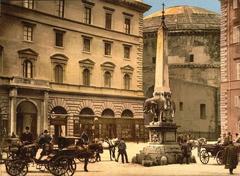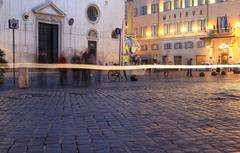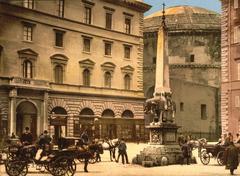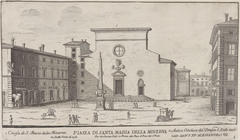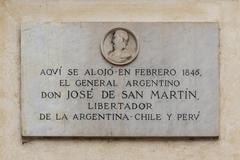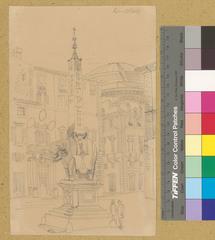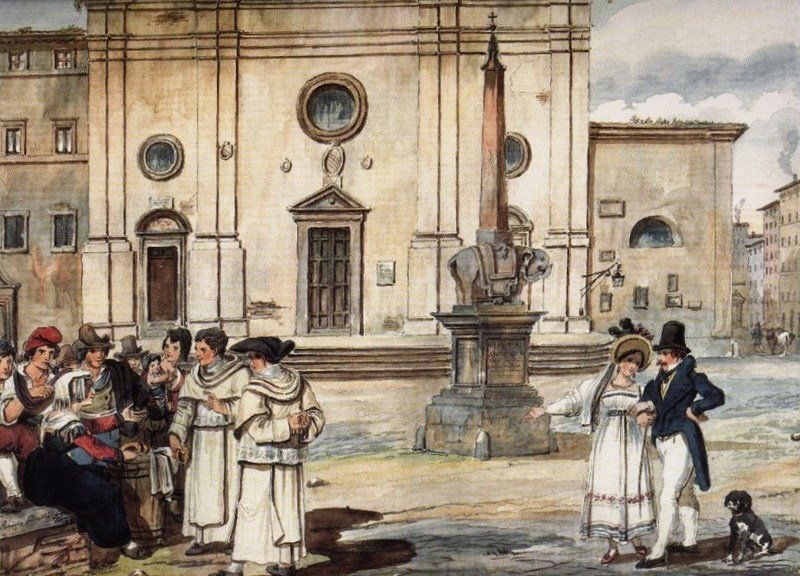
Piazza della Minerva Rome: Visiting Hours, Tickets, and Historical Sites Guide
Date: 14/06/2025
Introduction
Piazza della Minerva, tucked behind the Pantheon in Rome’s historic center, is a microcosm of the city’s rich tapestry—where ancient Rome, medieval spirituality, Renaissance artistry, and Baroque innovation converge. Its name recalls the ancient Temple of Minerva Chalcidica, once a focal point of wisdom and the arts in 1st-century BCE Rome (Turismo Roma; Roma Tour Guide). Today, visitors are greeted by Bernini’s whimsical Elephant and Obelisk, the only major Gothic church in Rome—Santa Maria sopra Minerva—and the echoes of pivotal moments in history, such as the trial of Galileo Galilei (Wikipedia).
This comprehensive guide covers the origins, art, cultural landmarks, practical information, and travel tips for experiencing Piazza della Minerva. Read on to discover its unique history, visiting hours, ticketing details, accessibility, and nearby attractions.
Table of Contents
- Introduction
- Ancient Origins and the Temple of Minerva
- Medieval and Renaissance Transformations
- Baroque Flourish: Bernini’s Elephant and Obelisk
- The Dominican Complex and the Inquisition
- Architectural and Cultural Landmarks
- Visitor Information: Hours, Tickets, and Accessibility
- Frequently Asked Questions (FAQ)
- Conclusion
- References
Ancient Origins and the Temple of Minerva
Piazza della Minerva stands on the site of the Temple of Minerva Chalcidica, commissioned by Pompey the Great in the 1st century BCE. Minerva, the Roman goddess of wisdom, arts, and strategic warfare, was worshipped here, marking the area as a center of learning and culture (Turismo Roma; Roma Tour Guide). Although the temple no longer survives, its statue, Minerva Calcidica, is preserved in the Vatican Museums (Wikipedia).
The square’s close proximity to the Pantheon further situates it at a crossroads of Rome’s religious and civic life, where ancient paganism gave way to Christianity.
Medieval and Renaissance Transformations
With the spread of Christianity, the Temple of Minerva was replaced by the Basilica di Santa Maria sopra Minerva. The church’s name—literally “above Minerva”—reflects this spiritual continuity and transformation (Turismo Roma; Walks of Italy). By the Middle Ages, the Dominicans established the Insula Sapientiae (“Island of Wisdom”) here, making it a major center for theological learning and ecclesiastical administration.
The basilica, built between the late 13th and 15th centuries, is Rome’s only major Gothic church. It houses masterpieces by Filippino Lippi, Antoniazzo Romano, and Michelangelo, and is the final resting place of Saint Catherine of Siena and Fra Angelico (Turismo Roma; Roma Tour Guide).
Baroque Flourish: Bernini’s Elephant and Obelisk
The piazza’s centerpiece, Bernini’s Elephant and Obelisk (1667), encapsulates the Baroque spirit. Commissioned by Pope Alexander VII, Bernini designed a marble elephant—realized by Ercole Ferrata—carrying an Egyptian obelisk from the 6th century BCE (Turismo Roma; Through Eternity). The sculpture playfully combines ancient Egyptian and Christian symbols, interpreted as the triumph of wisdom and faith over ignorance.
The monument, nicknamed “Pulcino della Minerva,” demonstrates Bernini’s mastery of movement and theatricality, while a Latin inscription at its base extols the strength needed to uphold true wisdom (The Roman Guy).
The Dominican Complex and the Inquisition
From the 17th century, the Dominican convent next to the basilica served as the seat of the Roman Inquisition. Here, in 1633, Galileo Galilei was famously forced to recant his heliocentric theories (Wikipedia; History.com). After the unification of Italy, much of the convent became state property, with the cloister now housing the Senate Library.
Architectural and Cultural Landmarks
- Basilica di Santa Maria sopra Minerva: Rome’s only major Gothic church, notable for its star-studded blue vault, Michelangelo’s “Christ the Redeemer,” and the Carafa Chapel frescoes by Filippino Lippi (Turismo Roma; Michelangelo’s Christ the Redeemer).
- Palazzo Fonseca and Accademia Ecclesiastica: These Renaissance and Baroque palaces house the Vatican’s diplomatic academy and other ecclesiastical institutions (Accademia Ecclesiastica).
- Palazzina della Minerva: Now part of the Italian Senate’s library, this historic building preserves thousands of volumes and rare documents (Turismo Roma).
Visitor Information: Hours, Tickets, and Accessibility
- Piazza della Minerva: Open public square, accessible 24/7.
- Basilica di Santa Maria sopra Minerva: Generally open 9:00 AM–7:00 PM daily; check the official website for variations during religious holidays.
- Tickets: The piazza and basilica are free to enter; donations are welcome. Some special exhibitions may require a ticket.
- Tours: Guided tours are available through various operators. Booking in advance is recommended.
- Accessibility: The square and basilica are wheelchair accessible, though some interior areas have minor limitations due to historical features.
- Getting There: Nearest metro station: Barberini (Line A), 10–15 minutes on foot. Multiple bus lines serve the area.
- Travel Tips: Visit early or late in the day for the best experience. Modest dress is required in the basilica.
Frequently Asked Questions (FAQ)
Q: Is there an entrance fee for Piazza della Minerva or the basilica?
A: No, both are free to enter; donations to the basilica are appreciated.
Q: What are the opening hours?
A: The square is open 24/7. The basilica is typically open 9:00 AM–7:00 PM but may vary during holidays.
Q: Are guided tours available?
A: Yes, book in advance for a deeper insight into the piazza’s history and art.
Q: Is the area accessible for visitors with disabilities?
A: Yes, but some church interiors may pose minor challenges due to steps or uneven flooring.
Q: What other attractions are nearby?
A: The Pantheon, Piazza Navona, and Church of Sant’Ignazio di Loyola are all within short walking distance.
Conclusion
Piazza della Minerva is a living testament to Rome’s evolving legacy—from ancient temples and medieval convents to Baroque masterpieces and pivotal moments in scientific history. Its tranquil square, Gothic basilica, and the playful yet profound Elephant and Obelisk make it a must-visit for those seeking the essence of Rome’s historical and cultural richness.
For the best experience, check current hours on official sites, consider a guided tour, and explore nearby landmarks. Download the Audiala app for offline guides and event updates, and follow official tourism portals for the latest information, especially during Jubilee 2025 (Papal Audience).
References
- Piazza della Minerva, Turismo Roma, 2024
- Piazza della Minerva: Un incantevole angolo di storia e cultura a Roma, Roma Tour Guide, 2024
- Virtual 360 Tour: Piazza della Minerva, Walks of Italy, 2024
- Piazza della Minerva, Wikipedia, 2025
- Bernini Elephant and Obelisk, Through Eternity, 2024
- Top Things to See at the Pantheon in Rome, The Roman Guy, 2024
- Basilica di Santa Maria Sopra Minerva, Turismo Roma, 2024
- Michelangelo’s Christ the Redeemer, Wanted in Rome, 2024
- Galileo’s Trial, History.com, 2024
- Roman Inquisition, Britannica, 2025
- Accademia Ecclesiastica, Vatican.va, 2024
- Rome’s Obelisks, Rome Art Lover, 2024
- Bernini’s Elephant and Obelisk, Italy Magazine, 2024
- Best Things to Do in Rome in June, Wanted in Rome, 2024
- Rome Jubilee 2025, Papal Audience Official Portal, 2024

